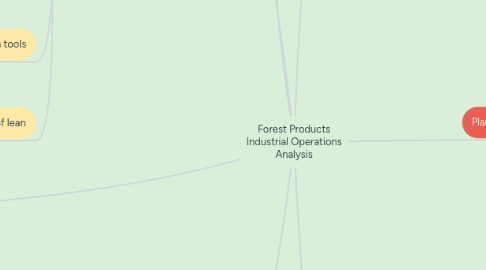
1. Process
2. Lean Manufacturing
2.1. Manufacturing without waste
2.2. Production of goods using less of everything
2.3. Also known as Toyota Production System (TPS)
2.4. seven (7) types of waste
2.4.1. Motion
2.4.2. Over production
2.4.3. Movement
2.4.4. Inventory
2.4.5. Poor processing
2.4.6. Waiting
2.4.7. Defects
2.5. Principle of lean
2.5.1. Specific value
2.5.2. Identify the value stream
2.5.3. Create flow
2.5.4. Customer pull product through value stream
2.5.5. Seek perfection
2.6. Lean tools
2.6.1. Poka Yoke
2.6.2. 5s visual workplace
2.6.3. Just in time
2.7. Understand the benefits of lean
3. Demand Forecasting
3.1. Understand qualitative forecasting technique with advantages and disadvantages of each
3.1.1. Hierarchical method
3.1.2. Expert opinion
3.1.3. Delphi method
3.1.4. Surveys
3.2. Solve problems on quantitative forecasting technique
3.2.1. Moving averages
3.2.2. Weighted moving averages
3.2.3. Exponential smoothing
3.2.4. Linear regression
3.3. Compare on qualitative and quantitative based on forecasting
4. Linear Programming
4.1. Understand the calculation of LP
4.2. Able to formulate small problem related to operations of forest product manufacturing
4.2.1. (with unit), Max Z ($/day) = 3($/pallet) x P(pallets/day) + 10($/mbf) x L(mbf/day)
4.3. Capable of analyze and interprete LP solution
4.3.1. (without unit), Max Z = 3 x P + 10 x L
5. Plant Layout
5.1. Three (3) types of layout
5.1.1. Fixed position
5.1.2. Product
5.2. The advantages and disadvantages of layout
5.3. Factor influencing the design layout
5.3.1. Nature of products
5.3.2. Type of machinery
5.3.3. Factory building
5.3.4. Production process
5.3.5. Repairs and maintenance
5.3.6. Human needs
5.3.7. Plant environment
5.3.8. Management policies
5.4. Software used for layout
5.4.1. ALDEP (Automated layout design program)
5.4.2. CORELAP (Computerized related allocation of facilities technique)
5.4.3. CALP (Computer Aided Layout Planning)
6. Plant Location
6.1. Locating the plant
6.2. Understand the location factor
6.2.1. Market related factor
6.2.2. Tangible factors
6.2.3. Intangible factors
6.3. Discriminate between tangible and intangible factors
6.4. Understanding the calculation towards center of gravity method
6.4.1. The importance of production and operation management
7. Production and Operation Management Concept
7.1. Production and operation management
7.2. Distinguish between good producer and service producer
7.3. Define production system
7.4. The elements of production system
7.4.1. Input
7.4.2. Output
7.4.3. Production process
7.4.4. Resources

